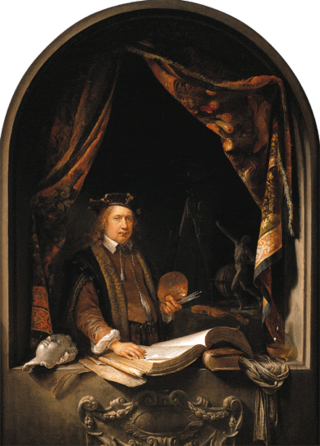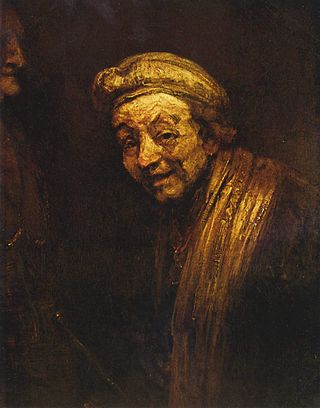
The Mauritshuis is an art museum in The Hague, Netherlands. The museum houses the Royal Cabinet of Paintings which consists of 854 objects, mostly Dutch Golden Age paintings. The collection contains works by Johannes Vermeer, Rembrandt van Rijn, Jan Steen, Paulus Potter, Frans Hals, Jacob van Ruisdael, Hans Holbein the Younger, and others. Originally, the 17th-century building was the residence of count John Maurice of Nassau. It is now the property of the government of the Netherlands and is listed in the top 100 Dutch heritage sites.

Gerrit Dou, also known as GerardDouw or Dow, was a Dutch Golden Age painter, whose small, highly polished paintings are typical of the Leiden fijnschilders. He specialised in genre scenes and is noted for his trompe-l'œil "niche" paintings and candlelit night-scenes with strong chiaroscuro. He was a student of Rembrandt.

Rembrandt Harmenszoon van Rijn, usually simply known as Rembrandt, was a Dutch Golden Age painter, printmaker and draughtsman. An innovative and prolific master in three media, he is generally considered one of the greatest visual artists in the history of art and the most important in Dutch art history. It is estimated Rembrandt produced a total of about three hundred paintings, three hundred etchings and two thousand drawings.

Aert de Gelder was a Dutch painter. He was the only Dutch artist to paint in the tradition of Rembrandt's late style into the 18th century.

Hendrickje Stoffels was the longtime partner of Rembrandt. The couple were unable to marry because of the financial settlement linked to the will of Rembrandt's deceased wife Saskia, but they remained together until Hendrickje's death. In 1654 she gave birth to Rembrandt's daughter Cornelia. In the later years of their relationship Hendrickje managed Rembrandt's business affairs together with the painter's son Titus.

Aristotle with a Bust of Homer, also known as Aristotle Contemplating a Bust of Homer, is an oil-on-canvas painting by Rembrandt that depicts Aristotle wearing a gold chain and contemplating a sculpted bust of Homer. It was created as a commission for Don Antonio Ruffo's collection. It was bought and sold by several collectors until it was eventually purchased by the Metropolitan Museum of Art. The mysterious tone in the painting has led several scholars to different interpretations of Rembrandt's theme.

Simeon in the Temple or Simeons song of praise is an oil on canvas painting by the Dutch artist Rembrandt from c. 1669. It has been in the collections of Nationalmuseum in Stockholm since 1949.

Self-Portrait with Two Circles is an oil-on-canvas painting by the Dutch artist Rembrandt, painted c. 1665–1669, one of over 40 painted self-portraits by Rembrandt.

Dr. Abraham Bredius was a Dutch art collector, art historian, and museum curator.

Diana and Her Companions is a painting by Dutch artist Johannes Vermeer completed in the early to mid-1650s, now at the Mauritshuis museum in The Hague. Although the exact year is unknown, the work may be the earliest painting of the artist still extant, with some art historians placing it before Christ in the House of Martha and Mary and some after.

The dozens of self-portraits by Rembrandt were an important part of his oeuvre. Rembrandt created approaching one hundred self-portraits including over forty paintings, thirty-one etchings and about seven drawings; some remain uncertain as to the identity of either the subject or the artist, or the definition of a portrait.
Sir Christopher John White CVO FBA is a British art historian and curator. He is the son of the artist and art administrator Gabriel White. He has specialized in the study of Rembrandt and Dutch Golden Age painting and printmaking.

Self-portrait as Zeuxis Laughing is one of over 40 painted self-portraits by Rembrandt. Painted around 1662 by the Dutch artist Rembrandt, it is now in the Wallraf-Richartz-Museum in Cologne.

Self-Portrait at the Age of 63 is a self-portrait by the Dutch artist Rembrandt. One of three dating to 1669, it was one of the last in his series of around 80 self-portraits, painted in the months before his death in October 1669. Despite the closeness of his death, and the concentration on his aging face, Rembrandt makes an impression of a self-assured and confident artist. It was bought by the National Gallery, London in 1851.

Self-Portrait at the Age of 34 is a self-portrait by Rembrandt, dating to 1640 and now in the National Gallery in London. The painting is one of many self-portraits by Rembrandt, in both painting and etching, to show the artist in a fancy costume from the previous century. In this case specific influences in the pose have long been recognised from Raphael's Portrait of Baldassare Castiglione and Titian's A Man with a Quilted Sleeve in the National Gallery. Rembrandt saw both of these in Amsterdam, in his day the centre of Europe's art trade, and made a sketch of the Raphael, with its price.

The Goldfinch is a painting by the Dutch Golden Age artist Carel Fabritius of a life-sized chained goldfinch. Signed and dated 1654, it is now in the collection of the Mauritshuis in The Hague, Netherlands. The work is a trompe-l'œil oil on panel measuring 33.5 by 22.8 centimetres that was once part of a larger structure, perhaps a window jamb or a protective cover. It is possible that the painting was in its creator's workshop in Delft at the time of the gunpowder explosion that killed him and destroyed much of the city.

Still Life with Cheeses, Almonds and Pretzels is a painting by the Flemish artist Clara Peeters, c. 1615. It is a still life, painted in oils on a wooden panel, measuring 34.5 cm × 49.5 cm. Peeters has painted her signature in the handle of the silver bridal knife. The painting is displayed in the Mauritshuis museum in The Hague.
Baron Willem van Dedem, also styled as Willem, Baron van Dedem, (1929–2015) was a Dutch businessman, art collector, art historian and philanthropist. He donated artworks to the National Gallery in London, the Rijksmuseum and the Mauritshuis.

Two Women with a Candle or Old Woman and Young Woman with a Candle is a 1616-1617 painting by Peter Paul Rubens, now in the Mauritshuis, The Hague, Netherlands. Its chiaroscuro shows strong influence from Caravaggio, whose work Rubens had seen during a stay in Rome.

Saul and David is an oil-on-canvas painting by Rembrandt and/or his studio, now in the Mauritshuis and dated to between 1651 and 1658.


















